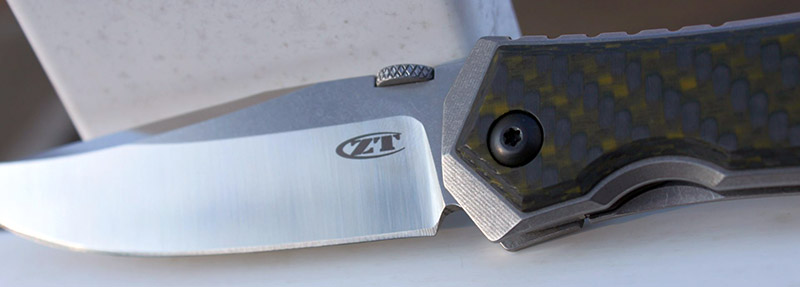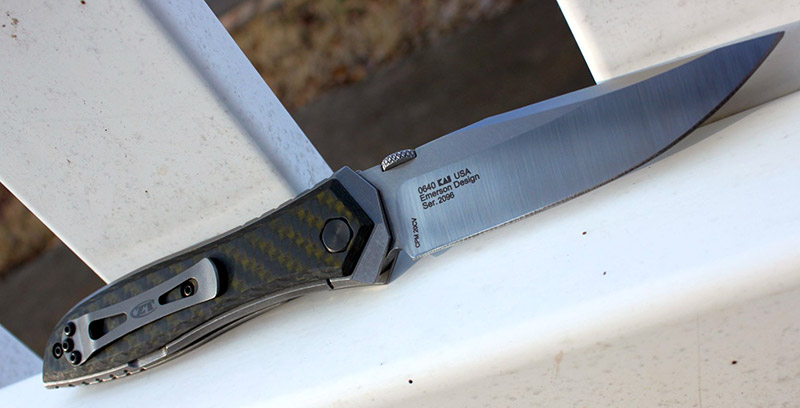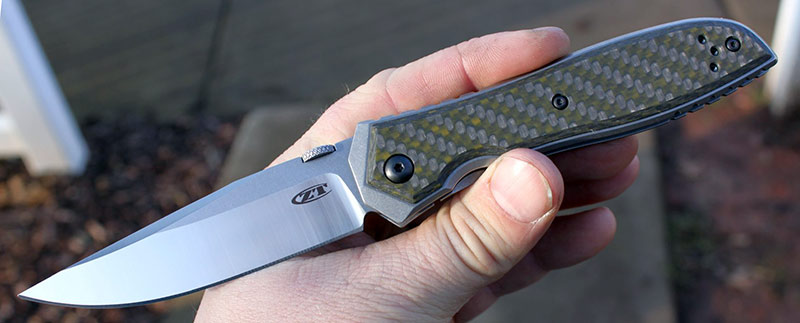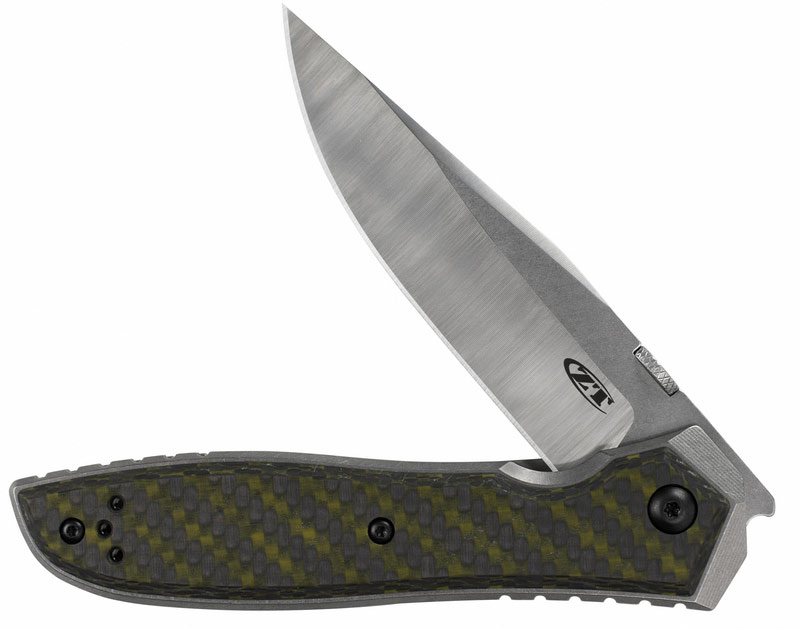We independently evaluate all recommended products and services. Any products or services put forward appear in no particular order. If you click on links we provide, we may receive compensation.
The ZT 0640 has been a somewhat controversial offering from Zero Tolerance, mostly from an aesthetic standpoint – but I think that tends to glance over the greater importance of this model for Zero Tolerance. To me, it’s a bit of return to form for the brand, who has in past years been spending a lot of time of building dramatic looking knives that are more art pieces than hard use tools. There have been some exceptions to this – like the now-dead 0909 and 0804CF – but lately Zero Tolerance has been focusing more on custom maker collaborations and high end conversation pieces than actual hard-use knives they were known for in the beginning.


I’d say they’re back, and I say that with the new Zero Tolerance 0640 in my pocket. Color me impressed, this is the second KAI product in a row I’ve tested that won me over almost immediately. There are a few caveats to this, but the Cliff’s Notes are this: ZT still builds high-end, no nonsense, big bold knives here in the USA you can actually use.
Key Specs: ZT 0640
The Blade
The 0640’s blade is, in my eyes, ideal for all-purpose tasks owing to its practical blade shape. Measuring a sizable 3.75” long (with a 3.625” cutting edge) it’s a well-balanced clip point shape, with the tip falling just slightly above center relative to the handle. It has a high flat grind, and a long false swedge that’s slightly concave in profile giving it the clip point profile.

Like a lot of the high-end ZT’s it has a two-tone blade finish, with the flats having a deep grainy stonewash and the primary bevel and swedge grind having a vertical satin finish. The plunge line is diagonal but close to vertical, leaving a very short ricasso. The way the plunge line intersects the sharpening choil (behind and above the termination of the sharpened edge) leaves a considerable “beard” at the rear of the blade, sure to annoy home sharpeners.
Blade steel here is a step up from the regular S35VN that ZT normally uses, with the 0640 featuring Crucible CPM-20CV steel. 20CV is widely considered one of the best high-end steels currently on the market, along with “fraternal twins” Carpenter CTS-204p and Bohler-Uddeholm M390 (as they all have fairly similar chemical makeups.)
Compared to industry benchmark S35VN, 20CV has around 37% more carbon content (the primary factor in edge retention and hardness), 42% more Chromium (hardness, toughness and corrosion resistance) and 33% more Vanadium (fine grain size). Although it’s not a fully scientific study (there are multiple variables that can’t be controlled), a good benchmark is Cedric & Ada’s steel testing results which count how many cuts a steel with a uniform edge can make through rope before it gets dull.

CPM 20CV is the third highest in 92 steels that he’s tested, with 351 cuts (behind CPM 10V with 389, and of course Maxamet with an insane 563.) For reference, S35VN makes between 187 and 198 cuts depending on the manufacturer and knife. So what that says is that in addition to being highly stain resistant, 20CV has a noticeable performance margin in terms of edge retention even over a well-regarded steel like CPM S35VN.
Deployment and Lockup
 The 0640 is interesting with regards to deployment for two reasons. It’s a ZT without ball bearings, and it’s an Emerson design without a wave. This is actually what drew me to the 0640 in the first place, the lack of bearings. It seems like every knife I’ve tested lately has been a bearing pivot flipper that puts an emphasis on super-fast deployment, stiff detent, and drop shut-action.
The 0640 is interesting with regards to deployment for two reasons. It’s a ZT without ball bearings, and it’s an Emerson design without a wave. This is actually what drew me to the 0640 in the first place, the lack of bearings. It seems like every knife I’ve tested lately has been a bearing pivot flipper that puts an emphasis on super-fast deployment, stiff detent, and drop shut-action.
They’re also maintenance-intensive, frequently requiring disassembly to clean lint and junk out of the bearing races once they start sounding gritty. Some of them are absolutely obnoxious to disassemble – you won’t catch me breaking down another CRKT with IKBS again. Bearings are smooth and they’re a fantastic party trick, but there’s nothing wrong with phosphor bronze washers. They just sit there, not requiring you to mess with them and clean them and buy fancy lube for them (they’re actually self-lubricating).
And if you’re really good at building knives, they’re smooth enough to just not matter. That was the case with the (sadly departed) ZT 0850, and it’s also the case with the 0640. You can tell that this knife isn’t on bearings – it doesn’t have that weird weightless floating feeling that lets knives like the Buck Marksman drop shut on your fingers, but it’s just absolutely hydraulic smooth.
Deployment is by thumb disc, which is an opener style I’m not super familiar with as I’ve never been big into Emersons. It seems well executed here, a small disc inset into and bolted to the top of the spine with knurled texturing around the edge for grip. It’s fully ambidextrous too. The detent isn’t particularly heavy, allowing you to pop the blade out quickly with a slight wrist flick but light enough to let you slowly roll the blade out as well. It’s purposeful and requires good technique to flip it open, but it’s much less in the way when cutting than a thumb stud would be.
Lockup is via a titanium liner lock that has a stainless insert bolted in- which also includes the detent ball. Lockup is very early even when flicking the knife open hard, and I’ve yet to experience any lock stick or vertical lock rock. After a few weeks of use I noticed a hair of horizontal play, which was easily tuned out by pivot tension. The 0640 uses an external stop pin to locate the blade in the open and closed positions, which is good for strength versus an internal pin (and prevents buildup of gunk in the stop pin channel as well.)
Features, Fit & Finish
This is a higher-end ZT that retails for $250, so good fit and finish is expected here. And for the most part it lives up to the expectation. The exception here is the same as with the Bareknuckle I reviewed previously – the hex head pivot is set in the carbon fiber handle scale. With the amount of loc-tite that ZT put on the pivot screw, as you begin to turn the pivot to loosen it the hex head starts to turn in the carbon fiber and round it out. I didn’t have the stomach to test my luck here and just left it as it was – thankfully the pivot was set up fine as it was, so I didn’t end up breaking the knife down to examine the inside of it.

The most controversial thing about this knife that I alluded to earlier are those carbon fiber scales. They’re a coarse weave carbon fiber with a greenish yellow shade woven in, and some people are just apoplectic about them having some color in them. I don’t get it. There are enough stonewashed slab-sided titanium knives and shiny lacquered carbon fiber handled knives out there to last a lifetime, and I like some color and personality.
The handles stand proud of the scales kind of like the Spyderco Gayle Bradley Folder – another high end knife with a focus on being a no-nonsense work tool – this gives the handle a more rounded feel in the hand for a better grip. They’ve included a row of coarse jimping on the front of the spine as well as the rear of the underside for traction in hand.

Construction is pretty typical, using two T6 screws to hold the scales to the handles and two T6 screws with hourglass standoffs to connect the handles. The aforementioned pivot is Chicago-style with a plain T8 male screw and the female pivot having the integrated hex head to keep it from spinning. The pocket clip is very thin (almost flat with the scales) and unique to the 0640, held in place with three T6 screws and configurable for left or right hand tip up carry. It’s easily cleaned out with compressed air and oiled thanks to flow-through construction.
Fit and finish on this knife is really quite good, with the kind of details and satisfying touches that elevate a high end piece like this from everyday knives while not getting in the way of actual function. The leading edges of the handles, revealed by the cut away scales, have a series of super fine lines milled into them in an arrow pattern. The edges of the carbon fiber scales are chamfered revealing the 3D structure of the material on the sides (no carbon fiber laminated G10 here!) The edge of the thumb disc has an interlacing “x” pattern cut into it with jeweler’s precision, and the two-tone finish on the blade is executed absolutely perfectly.
It’s all so beautiful without being flashy or over the top, no goofy Mokuti or bright contrasting colors or obnoxious logos. In fact, branding is pretty minimal on the 0640 – the ZT logo on the show side of the blade and on the pocket clip, and basic information on the lock side of the blade (model number, “KAI USA”, Emerson Design, the serial number, and “CPM 20CV” parallel with the plunge line) laser etched in small font. It’s the kind of high quality tool that’s appreciated over time and with use rather than immediately hitting the user with a lot of visual “wow.”
Field Test
I really loved using the 0640, with one caveat: that pocket clip. It depends on what kind of pants you’re wearing: it just didn’t work with one pair of jeans I own, basically requiring you to partially lift the clip up before sliding it over the pocket seam, and feeling like it was going to literally eat the denim. The entry angle on the clip is extremely low, and the clip itself is very stiff and nearly flat, so when you did get it into your pocket the clip stuck out noticeably and had a tendency to drag on door frames. It’s also mounted such that quite a bit of the knife sticks out of your pocket. Thankfully the 0640 is designed so that you can use Emerson or Steel Flame clips, but I think they should just include a usable clip with the knife in the first place.

Despite the bummer of a clip, the 0640 carries okay considering its size and weight (4.4oz). At least it has a pretty slim vertical profile (from blade spine to handle spine when closed) relative to its size – no flipper tab or thumb stud getting in the way. It’s still pretty thick – 0.54” wide across the handles, and you always know it’s in your pocket. Still, thanks to the high clip tension it’s never going to accidentally slide out!
Actual use is excellent, though. The simple handle shape is an ergonomic masterpiece, with lots of traction and virtually no hot spots. The handle is four and three quarters inches long so there’s no shortage of space for a full grip, and the lockbar release cutout makes a nice mild forefinger choil. There’s no forward choil, but the grip is still secure enough to not need it, and the leading edge of the spine forms a very mild thumb ramp to help keep your hand in place with the jimping. The thumb disc doesn’t get in the way of what you’re cutting either. Having the scales cut away from the edges of the handles at an angle gives the knife a more rounded grip in hand and feels natural in use.

I can’t tell you what it’s like to sharpen 20CV because I haven’t had to yet. It arrived terrifically sharp out of the box and more than 2 months of everyday use has it still sharp enough to slice paper – it’s impressive edge retention even compared with other powdered metal steels like CPM S35VN. It’s also shown no signs of patina even with exposure to coolant and brake fluid. It seems to me like the rumors of this steels’ top-tier performance are true, although I’m sure it will be unpleasant to sharpen. The closest steel I have experience with is CPM S110V, but I’ve found it is much more prone to chipping than 20CV is. This is all-time-great level steel for EDC use.
As I said earlier, my first attempt to disassemble the knife was met with the hex head female side of the pivot starting to turn in the carbon fiber, so I aborted. I’ve been using compressed air to clean out the 0640 and that works fine for me. I do wish KAI would do something about this issue.
Alternatives
All these knives available at BladeHQ.
As I’ve mentioned before, the 0640 reminds me a lot of the Gayle Bradley folder I reviewed a few years ago. That’s no longer in production, but it was replaced by the Gayle Bradley 2 which is a little slimmed down and lighter – but still the same formula. It uses beefy skeletonized stainless liners covered by carbon fiber/G10 laminate scales and a hollow-ground drop point blade in CPM-M4 steel. CPM-M4 is a non-stainless steel with extremely impressive edge retention and toughness but is very corrosion prone. It’s a good bit cheaper than the 0640 at $160 retail, but it doesn’t have some of the expensive components like the 0640’s titanium liners and full carbon scales. I still don’t like the total lack of a lockbar release cutout, but it’s a great performing knife and it has a lot of character.
Want an actual Emerson? There’s no direct analog to the 0640 in Ernie’s lineup, but the Emerson Patriot does have some similarities. The blade’s a bit longer at 3.875”, and being an Emerson it’s V-ground but chisel edged: mean it has a symmetrical primary grind but the edge bevel is only on one side – to make it easier to sharpen in situ. As is the norm, you get a better deal buying an Emerson-designed ZT than an actual Emerson (and the same can be said for Hinderers, too) – for about the same price, the Emerson has mid-range 154CM steel and plain G10 handle scales over titanium liners. It does feature the wave opener than the 0640 lacks, but it’s also almost 2 ounces heavier. Still, if you won’t settle for anything but the real deal…

If a big elegant clip point is your bag but you’d rather skip the “tactical” aspect, then the full-sized Benchmade 15080 Crooked River might be more your speed. It features a gargantuan 4” clip point blade in CPM S30V steel, and Benchmade’s signature Axis Lock feature to allow safe one handed opening and closing action. You have a choice between grey textured G10 or “Dymondwood” (which is stabilized wood, called different things by different brands) but both models feature anodized aluminum bolsters and an orange backspacer and pivot collar. They’re almost exactly an ounce heavier than the 0640, but they’re also 0.8” longer overall. There’s also a “Mini” Crooked River that’s $15 cheaper ($191 vs $208 for the full size) that has a 3.4” blade.

For something a little more affordable, the new folding version of the Cold Steel Bush Ranger seems like a great deal. It has a 3.5” flat ground clip point blade made from CPM S35VN steel, and also uses a thumb disc for opening. The blade is held in place with the super-tough but not-much-fun Tri-Ad Lock, a revision of the classis backlock by renowned designer Andrew Demko which places a stop pin between the blade tang and the lockbar for stability. There’s no carbon fiber or titanium, but it is about half the price of the 0640 at $134 retail. It does have contoured G10 handles and an ambidextrous tip up pocket clip, though.

While it’s expensive compared to the Cold Steel, the 0640 is cheap compared to a Chris Reeve Large Sebenza. A far-fetched comparison to the long lived icon of titanium framelocks? Hardly. The ZT boasts significantly better steel than the Seb, and if you want the carbon fiber overlays similar to the 0640 then the pricetag is $300 more than the ZT. It also doesn’t have a steel insert on the lock bar, although CRK will tell you it doesn’t need one. It’s an icon but it’s becoming a tough sell these days.
Wrap-up
I really love the 0640, and I figured I would from the first time I saw one. It’s my kind of knife, with very few caveats. I like that it’s a return the old Zero Tolerance that I first got acquainted with around ten years ago when I first started dipping my toes into “real knives.” That’s not to say that I don’t like what ZT has been doing lately – some of their high end knives like the 0454 are just stunning pieces of usable engineering. But when I think of ZT I think of tough workhorse knives that you can trust to do anything you need without trouble, and this is it. It’s solid, dependable, and offers top notch performance and blade steel without weighing your pockets down like some of the old drastically overbuilt models used to. In fact, the 0640 is almost half the weight of the 0301.

I do wish they’d fix the spinning hex head pivot problem they’ve had for quite a long time now, and to be honest the pocket clip is a major nuisance. That’s okay: I haven’t had to take the knife apart since it has flow through construction anyway. (My Spyderco Manix 2 LW can’t be taken apart at all due to pinned construction and it’s still just fine after more than 5 years of use.) The clip issue can be solved with an aftermarket clip but I do wish ZT included a better clip in the first place – there’s always room for improvement.
I think one of my favorite things about it, conversely, are the phosphor bronze washers. We’ve spent so many years in this industry lauding the progress of ball bearing pivots, and to be sure when done right they’re a lot of fun to fidget with. But in terms of actual use they have no advantages over good washers, and they have downsides. Maintenance and cleaning are facts of life with bearings that you just don’t have to worry about with washers, and the washers on this knife are so smooth than the difference is negligible to me.
It’s a pricey knife but it has the materials to suit – everything on this knife is top of the line as far that goes, and it performs how it should considering. In many ways it reminds of a Large Sebenza – a tool made with high end materials that’s simple and deeply satisfying to use – it feels like a lifetime tool to me.
- CPM-20CV steel is an amazing performer, phosphor bronze washers are flawlessly smooth and low maintenance, top-notch materials and quality, great cutter, excellent ergonomics
- Hex head pivot will turn in carbon fiber scale, pocket clip is terrible, a bit pricey
ZT 0640
Quality/Performance - 84%
Value for Money - 82%
83%
An heirloom-worthy knife from ZT that’s a partial return to the stuff that made them famous in the first place. An absolute winner.
Words and pictures: James Mackintosh





